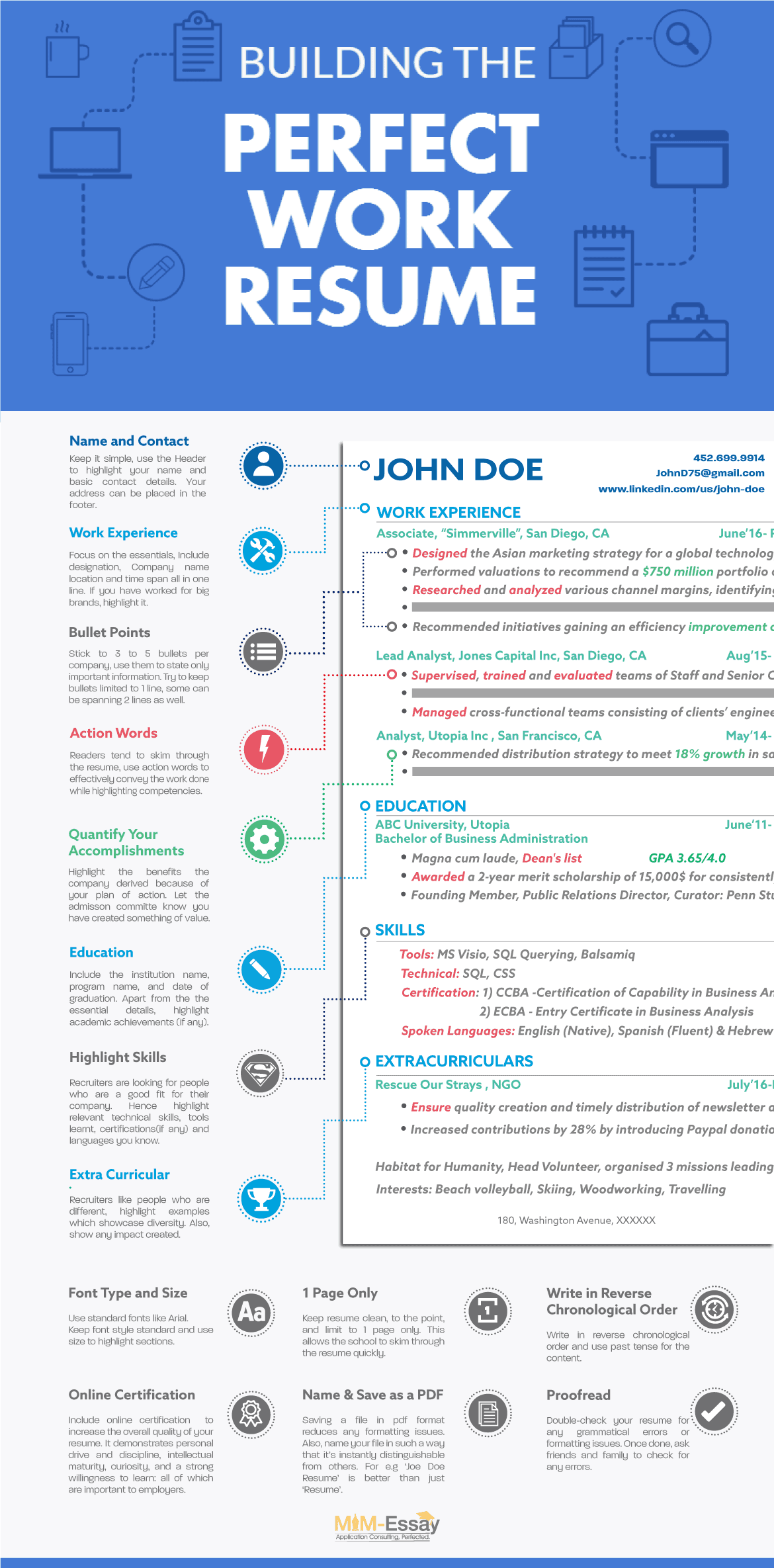Your job resume is the first impression that your future employer has of you. And we all know that first impressions matter a lot. Your resume has a crucial few seconds before the recruiter decides whether to shortlist you or toss it in the never-ending pile of rejected resumes.
Let’s take John’s case for example.
John is a pretty regular guy.
After completing his bachelor's, he started looking for a job like everyone else. He took Bryan’s conventional job resume for reference and made an identical resume except for making a few changes.
After that, he uploaded his resume on all the major job sites. He also applied to job fairs and sent his resume to friends for referrals at their companies.
After sending his resume to 100s of jobs, he waited.
The result? Except for attending interviews at 2-3 companies, it’s almost 2 months since he’s last received calls from any of the other places he’s applied to.
Sounds familiar?
A lot of people tend to use the same conventional format, use the same action words (You’ll learn more about action words in the Work Experience section down below) and, in fact, list the same set of hobbies that everyone else has added in their job resume.
In today’s world, with so much competition, you need to stand out from the rest of the crowd. Google receives around 2 million applicants each year. On a typical day, a recruiter has to go through hundreds of job resumes and scans through each one for only 15-20 seconds. We at MiM-Essay have seen the impact a good resume can make and hence have come out with a nifty list of 23 actionable points.
Follow these 23 useful resume writing tips and create the perfect job resume that gets the attention it deserves.
Once you implement all the tips in your job resume, we are confident that your chances of getting shortlisted for job interviews will increase significantly.

Now that you have a general understanding of what an Work Resume should and should not contain, let’s go through each section step by step.
![images/blogs/contentImages/resume-writing-tips-format.jpeg]()
![images/blogs/contentImages/resume-writing-tips-step-1.png]() KEEP IT UNCOMPLICATED
KEEP IT UNCOMPLICATED
A recruiter has only 15-20 seconds to look at your resume and decide whether you would be a good fit. Don’t make it harder for him than it already is.
First of all, make sure your resume should fit within a page. Keep the information concise as much as possible.

Also, do not overdo your resume by adding watermarks, designs, backgrounds, etc. Having too much of it, distracts the reader from accessing information he’s looking for in the first place. So, keep your resume readable and easy to read.
Want someone to help you design a simple yet creative resume?
You have got online tools such as myperfectresume.com, resumebuilder.org, and resume-now.com to make your life easier.
![images/blogs/contentImages/resume-writing-tips-step-2.png]() FONTS MATTER – STANDARDISE THEM.
FONTS MATTER – STANDARDISE THEM.
What should the font size be?
The header, which includes your name, should be between 20 and 22. The section head could range from 12 to 14, while the main body should be between 10 and 12. Use a standard font like Arial or Times New Roman.

You could also choose from Calibri, Garamond, Trebuchet MS, Georgia, and Helvetica. These fonts are legible, give your resume a fluid look, and make it stand apart from others.
A word of caution here: don’t try to mix and match fonts.
Stick to one font throughout the resume.
Also, use bold, italics, etc, to organise your resume.
If you keep the text in your resume plain, it will look dry and not easy on the eyes.
For example, you can bold the name of the companies you have worked in, the name of your college/ university, and your designation in the company while highlighting a specific action word or important stat.

![images/blogs/contentImages/resume-writing-tips-step-3.png]() MENTION ONLY RELEVANT CONTACT DETAILS
MENTION ONLY RELEVANT CONTACT DETAILS
![]()
Your name is your personal brand and should be at the very top. Just like a headline is associated with the text written below it, similarly, your name, followed by the rest of the info, will tell the story to the reader. Therefore, you might make your name a bit larger in font than the rest of your resume, or bold your name, or both.
Mention your phone number, country code, and appropriate email address. Refrain from using inappropriate email addresses like thecoolguy@gmail.com. It is best to stick to a name variation that seems official.
For example, for someone like John, a good email username can be JohnD75@gmail.com.
In the header, the phone number and email address should be enough in most cases.
You can also include a link to your LinkedIn profile, but make sure it is updated and matches with the resume.
![images/blogs/contentImages/resume-writing-tips-step-4.png]() SKIP THE OBJECTIVE STATEMENT
SKIP THE OBJECTIVE STATEMENT
An objective is a short statement at the top of your job resume (right after your essential contact details) that summarizes for the reader where you are in your career and what you’re seeking as the next step.
It was common practice to include an objective statement in the past, but no one is interested in reading it anymore.
Remember, the employer is interested in your skills and capabilities, and the objective statement cannot state that.

If you analyse this statement, it tells nothing suitable about the skill set or the experience of the candidate.
It sounds ambiguous at best.
Also, who does not want to work in such an environment? So, there is no differentiation factor here.
Hence, the lesson here is to skip the objective statement.
![images/blogs/contentImages/resume-writing-tips-work-experience.jpeg]()
![images/blogs/contentImages/resume-writing-tips-step-5.png]() BE SELECTIVE WITH YOUR CONTENT
BE SELECTIVE WITH YOUR CONTENT
You don’t necessarily need to list every job you’ve had on your resume. If you have been working for several years, many career experts say you should only mention the most recent and relevant work experience.
As for recent graduates, no need to list all the internships you have done. Just mention those that are relevant to the job you’re applying for.
If you don’t have any relevant experience, there’s no need to worry. Focus on the skills they are looking out for and mention the relevant skills in the skills section you possess to thrive in the new job.
For e.g. If you’re applying for a Business Analyst position, there’s no need to add the editorial internship you did at that xyz magazine. Instead, add bullet points to prior work experience (Lead Analyst & Analyst) and describe your work-related responsibilities in detail.
![images/blogs/contentImages/resume-writing-tips-step-6.png]() OPTIMIZE YOUR BULLET POINTS
OPTIMIZE YOUR BULLET POINTS
Remember that recruiters tend to skim through data; hence, large blocks of text will not be read. Bullet points are the most effective way to express information.
Keep your bullets to 1 – 2 lines (and, ideally, about half or more of those bullets should be one line).
They should be the same size and shape in each section and aligned from page to page.

You should also take into consideration that no matter how long you have been working somewhere or how many work accomplishments you have, you shouldn’t list more than 3-5 bullets per company. Most of the recruiters won’t read beyond 3.
Now that you have optimised your bullet points make sure you capture the recruiter’s attention by…
![images/blogs/contentImages/resume-writing-tips-step-7.png]() QUANTIFY YOUR BULLET POINTS
QUANTIFY YOUR BULLET POINTS
Let’s get to the point.

Which sounds better?
Exactly.
Example B paints a better picture to the recruiter about your previous job responsibilities. It also shows that you have added value to the previous company, which recruiters want to know. Plus, it’s easier to skim through the points that contain facts and figures as opposed to just plain text.
Here are a few more examples.
Use as many facts, figures, and numbers as you can in your bullet points. If you still find it difficult, check out this article on how to do it.
![images/blogs/contentImages/resume-writing-tips-step-8.png]() THE ‘SO WHAT’ TEST..
THE ‘SO WHAT’ TEST..
You can use the “So What?” test for optimising your bullet points.
After writing a bullet point, analyse the content and ask yourself, ‘So what?’ to check whether the point highlights your capability.
Think about what difference it made. How much faster? What was it before? How much money or time did it save?
So it can be converted into something like


Once you are sure on how to implement the above tip, the next thing to focus on is..


![images/blogs/contentImages/resume-writing-tips-step-9.png]() ARE ACTION WORDS THAT IMPORTANT?
ARE ACTION WORDS THAT IMPORTANT?
Imagine how boring it would be for the recruiter if all your bullet points started with the ‘Responsible for..’ phrase. No matter how good your achievements are, he might just skip the entire list after reading just 2 points. That’s why it’s important to use Action words.
Action Words play an important role at the start of every bullet point. Think of skimming through a resume and coming across words such as “Was, Did, and Made,” as opposed to “Managed, Spearheaded, and Created.”
The latter group of words sounds more interesting and stronger and can help you set the tone for your resume.
A good resume tip would be using an action word. Sometimes, the same job can be described in a different manner, creating a completely different impression for the reviewer.
For example,

Hence make sure you start most of your points with action words.
In fact, most companies have softwares which search specifically for such action words and filter resumes based on it.

Hence you can realize the importance of the same.
Action word comes in varied forms, here are some mentioned below: –

Also avoid using vague terms like – Team player, Hard worker, Detail oriented, Thinks outside the box, etc. Almost everyone uses them in their resume and they mean nothing to the recruiter.
![images/blogs/contentImages/resume-writing-tips-step-10.png]() TRANSLATE TECHNICAL JARGON INTO SIMPLE LANGUAGE
TRANSLATE TECHNICAL JARGON INTO SIMPLE LANGUAGE
Have your job resume structured in such a way that it’s readable by an average person.
Never include technical jargon while you write your resume. While you might want to show that you know something, not everyone will be familiar with the jargons, particularly if you’re applying to a different industry.
And you never know who’s going to read it next. It could be the office staff, the assistant or the recruiter himself. Make it easy-to-read for all of them.

![images/blogs/contentImages/resume-writing-tips-step-11.png]() REVERSE CHRONOLOGICAL ORDER IS IMPORTANT
REVERSE CHRONOLOGICAL ORDER IS IMPORTANT
Another useful resume writing tip to remember is to write this section in reverse chronological order.
So your current job role comes first followed by previous job/internships.
Lastly, make sure all job responsibilities apart from your current job are in past tense.
Note: If you are a fresher, your resume may look bare. Introspect on internships done, or any freelance jobs which you might have done and the skills gained.
If you have done your final year projects with some external research/industrial entity – that can be mentioned here under Internship.ke it easy-to-read for all of them.

![images/blogs/contentImages/resume-writing-tips-step-12.png]() HIGHLIGHT EDUCATIONAL ACHIEVEMENTS.
HIGHLIGHT EDUCATIONAL ACHIEVEMENTS.
Always list your educational qualifications after your work experience. Employers are more interested in the work that you have done than where you went to college.
If you are a recent graduate, it’s alright to list your education first followed by internships.

Highlight achievements such as academic honors, club positions, etc which might be relevant to your future employer. If you got a scholarship, be sure to mention that as well.

Hiring managers know that past achievement usually predicts future performance. They also know that achievers are self-starters, motivated, and an asset to their company.

![images/blogs/contentImages/resume-writing-tips-step-13.png]() GETTING AN ONLINE CERTIFICATION? MENTION IT.
GETTING AN ONLINE CERTIFICATION? MENTION IT.
If you have done some online course, be sure to mention that as well. It shows that you have a thirst for knowledge and are ready to pursue it after regular hours. This might come off as a positive sign on your job resume.
Also, include any certifications that you might have done are relevant to the position you’re applying for, in this section.

![images/blogs/contentImages/resume-writing-tips-step-14.png]() MENTION ONLY RELEVANT SKILLS
MENTION ONLY RELEVANT SKILLS
Again, this is one section where many people go wrong. You don’t need to add all the skills you have just to make this space look bigger.
The company you’re interviewing with are looking for a specific set of skills in their prospective employee to get the job done. Therefore, read the job description carefully and list down the skills that they are looking for in a candidate. Mention them in your resume if you have any.
Also, if you have worked on any tool at your previous workplace that they have included in their job description, include it in your resume. It helps recruiter understand how much prepared you’re for your new role.
For e.g. If you are applying for the position of Lead Analyst, your skills section could look like this –

Also, please don’t include the usual ‘MS Word, E-mail, MS Excel, etc’ while writing your resume. Recruiters assume you possess those skills already.
![images/blogs/contentImages/resume-writing-tips-step-15.png]() HAVE YOU VOLUNTEERED AT A NGO? MENTION IT
HAVE YOU VOLUNTEERED AT A NGO? MENTION IT
Adding volunteer work is an excellent way to showcase skills such as event planning, teamwork, fundraising, etc. Most companies look favourably upon employees who contribute in a positive way to the surrounding community.
If you have been a part of / volunteered for an NGO, a student-run organization, etc. make sure you include that while writing your job resume.
Also, highlight the part you played while working there. Don’t simply list ‘I volunteered for xyz organization’. Statements like ‘Coordinated and led work parties that constructed 15 homes for low-income families in need of housing’ showcases your leadership and management qualities and adds significant value to your resume.
Framing points in this way helps readers connect the dots, and understand the relevance of your work, this principle is used heavily to make Masters Application Essays stand out, and can be emulated in the resume as well.

![images/blogs/contentImages/resume-writing-tips-step-16.png]() DO YOU HAVE ANY SPECIFIC INTERESTS?
DO YOU HAVE ANY SPECIFIC INTERESTS?
Reading books, watching sitcoms, sports, traveling, scrapbooking, shopping, playing guitar, etc. are some of the most common activities seen in the interests section.
No need to list all of them. A good resume writing tip is to research the company you’re applying for to find out what personal interests to put on a resume.
If the job requires you to be “outgoing and a good team player”, sports are good hobbies to mention on your resume. Reading books and watching sitcoms are not.
Also, check out this amazing article to see what hobbies & interests to include in your job resume.
![images/blogs/contentImages/resume-writing-tips-step-17.png]() AND THE AWARD GOES TO..
AND THE AWARD GOES TO..
If you have received any awards (Workplace or otherwise) in the recent past, feel free to list them in your resume. You can highlight them in their respective sections while writing your resume.
Also, add some background information (What does the award mean, What it took to get it, etc.) to help the recruiter get to know you better.

If you have received any awards in extracurriculars, mention it in the interests section in the form of a bullet point.
![images/blogs/contentImages/resume-writing-tips-awards.png]()
![images/blogs/contentImages/resume-writing-tips-step-18.png]() DO YOU KNOW MORE THAN 1 LANGUAGE?
DO YOU KNOW MORE THAN 1 LANGUAGE?
Ah! Should you add the languages you know in your resume or not? And what if you just know the basics? What do you do then?
According to this quora answer,
You can use the standard terms of proficiency such as ‘native’, ‘basic’, ‘fluent’, ‘intermediate’ or otherwise to describe how well you speak.


![images/blogs/contentImages/resume-writing-tips-step-19.png]() PERFECT THE GRAMMAR
PERFECT THE GRAMMAR
Your job resume is your introduction to the recruiter. It’s their first impression of you, and the last thing you want is to look careless or silly. Resume grammar mistakes can completely sabotage your chances of getting your dream job.
Some kinds of resume grammar mistakes are word choices, spelling errors, and punctuation errors.
In order to avoid such mistakes, make sure you have the resume proofread from another person.
Also, there are some other things you can look into to give your resume that extra edge
i) Active voice vs Passive voice
Active voice describes a sentence where the subject performs the action stated by the verb.
In passive voice sentences, the subject is acted upon by the verb.
To craft a powerful resume, avoid passive language as much as possible. Write the resume using active voice.
Not only is it better grammar to use the active tense, but it also conveys a more direct, driven and in control feeling from the resume.
Passive Voice (seems as if the promotion just happened)
.png)
Active Voice (gives the candidate more credit for the activity)

ii) Make correct use of Tense
When talking about earlier Jobs and responsibilities held; always refer to them in the past tense
When talking about your present job and responsibilities; use the present tense
![images/blogs/contentImages/resume-writing-tips-step-20.png]() HOW TO DEAL WITH GAPS
HOW TO DEAL WITH GAPS
Another overlooked resume writing tip that we are going to talk about in this section is how to deal with gaps.
If you have a few months of gap period between two consecutive jobs, you can make it less of an issue by eliminating the start and end dates of the previous jobs in the work-ex section.
Just mention the year for each of the jobs. If asked during the interview, be honest about it.
Make sure you mention any volunteer work, skills that you have picked up during the gap period.
![images/blogs/contentImages/resume-writing-tips-step-21.png]() PROOF READ! PROOF READ! PROOF READ!
PROOF READ! PROOF READ! PROOF READ!
You don’t have to be a grammar nazi! But you cannot make silly grammar errors.
Use read out loud function in MS Word to hear your resume and check for mistakes. You can also ask your friends and family for any error-checks.
While writing your resume, one important thing to remember is DO NOT rely on MS Word for spell check as it doesn’t have contextual spell check.
![images/blogs/contentImages/resume-writing-tips-step-22.png]() SAVE IT AS A PDF
SAVE IT AS A PDF
Always send your file in a pdf format. Period.
Imagine this. The recruiter has to shortlist 4 out of 10 candidates in the next 5 minutes. He opens your resume (sent in .doc format) and sees it all jumbled up due to some formatting issue. Do you think you still will be getting shortlisted because you’re the most deserving candidate?
No. The recruiter will simply close your resume and move on to the next resume. Hence, it’s always a recommended to send your resume in .pdf format to avoid such issues.
![images/blogs/contentImages/resume-writing-tips-step-23.png]() NAME YOUR FILE SMARTLY
NAME YOUR FILE SMARTLY
When naming your resume, do it intelligently. Name your file in such a way that it’s instantly distinguishable from others. For e.g. ‘John Doe Resume’ is better than just ‘Resume’â â â â .
CONCLUSION
With a typical recruiter spending only a few seconds going through your resume, the importance of a good resume cannot be debated. Having a good resume is sure to create that good first impression on him or her and turn the odds in your favour.
Following the above-mentioned 23 resume writing tips to create the perfect resume will substantially increase your chances of getting closer to your dream job. But we know that it is difficult to retain all the information you come across in one go.
You can also use it as a checklist when you are making a job resume of your own.
Now go get that job you were eyeing!









 KEEP IT UNCOMPLICATED
KEEP IT UNCOMPLICATED FONTS MATTER – STANDARDISE THEM.
FONTS MATTER – STANDARDISE THEM. MENTION ONLY RELEVANT CONTACT DETAILS
MENTION ONLY RELEVANT CONTACT DETAILS.png)
 SKIP THE OBJECTIVE STATEMENT
SKIP THE OBJECTIVE STATEMENT
 BE SELECTIVE WITH YOUR CONTENT
BE SELECTIVE WITH YOUR CONTENT OPTIMIZE YOUR BULLET POINTS
OPTIMIZE YOUR BULLET POINTS QUANTIFY YOUR BULLET POINTS
QUANTIFY YOUR BULLET POINTS THE ‘SO WHAT’ TEST..
THE ‘SO WHAT’ TEST.. ARE ACTION WORDS THAT IMPORTANT?
ARE ACTION WORDS THAT IMPORTANT? TRANSLATE TECHNICAL JARGON INTO SIMPLE LANGUAGE
TRANSLATE TECHNICAL JARGON INTO SIMPLE LANGUAGE REVERSE CHRONOLOGICAL ORDER IS IMPORTANT
REVERSE CHRONOLOGICAL ORDER IS IMPORTANT HIGHLIGHT EDUCATIONAL ACHIEVEMENTS.
HIGHLIGHT EDUCATIONAL ACHIEVEMENTS. GETTING AN ONLINE CERTIFICATION? MENTION IT.
GETTING AN ONLINE CERTIFICATION? MENTION IT. MENTION ONLY RELEVANT SKILLS
MENTION ONLY RELEVANT SKILLS HAVE YOU VOLUNTEERED AT A NGO? MENTION IT
HAVE YOU VOLUNTEERED AT A NGO? MENTION IT DO YOU HAVE ANY SPECIFIC INTERESTS?
DO YOU HAVE ANY SPECIFIC INTERESTS? AND THE AWARD GOES TO..
AND THE AWARD GOES TO..
 DO YOU KNOW MORE THAN 1 LANGUAGE?
DO YOU KNOW MORE THAN 1 LANGUAGE? PERFECT THE GRAMMAR
PERFECT THE GRAMMAR HOW TO DEAL WITH GAPS
HOW TO DEAL WITH GAPS PROOF READ! PROOF READ! PROOF READ!
PROOF READ! PROOF READ! PROOF READ! SAVE IT AS A PDF
SAVE IT AS A PDF NAME YOUR FILE SMARTLY
NAME YOUR FILE SMARTLY